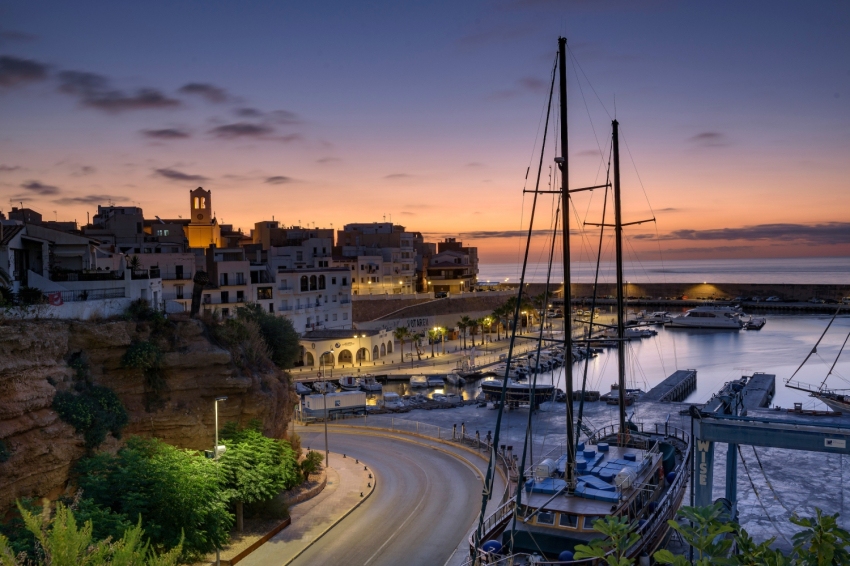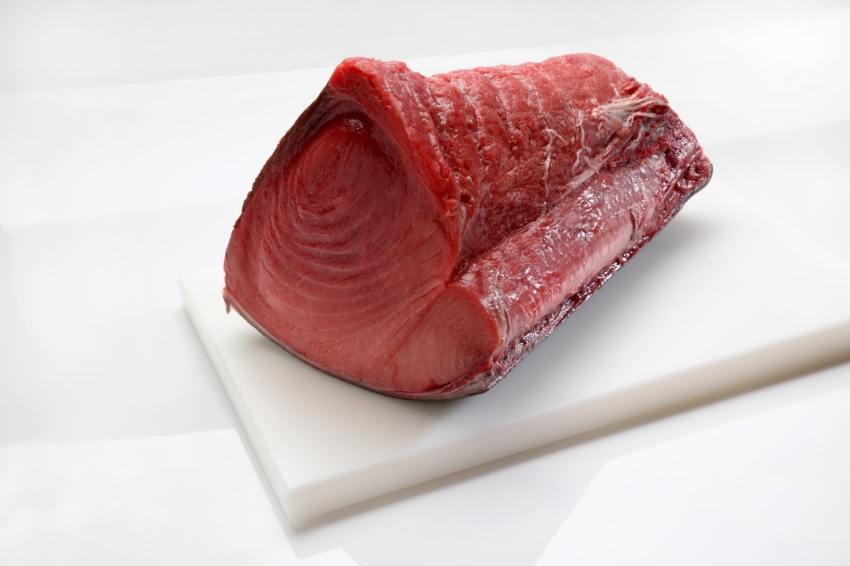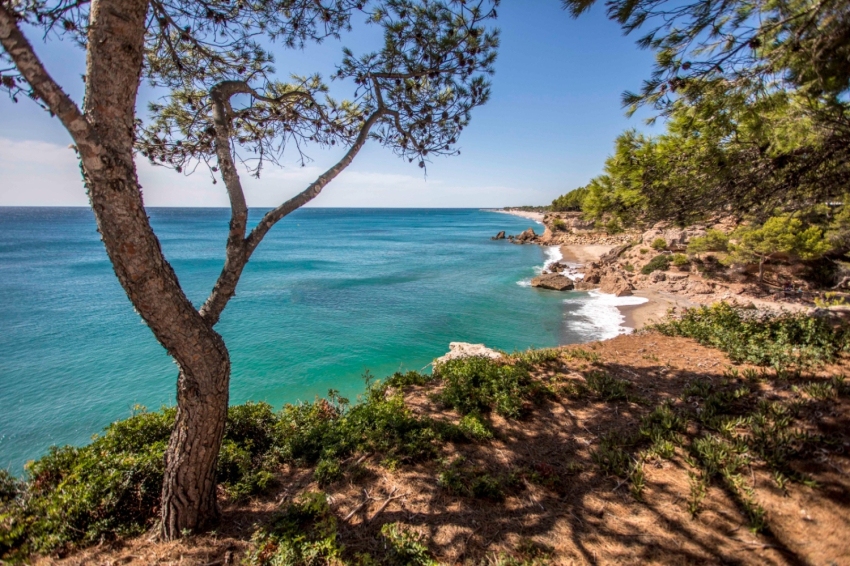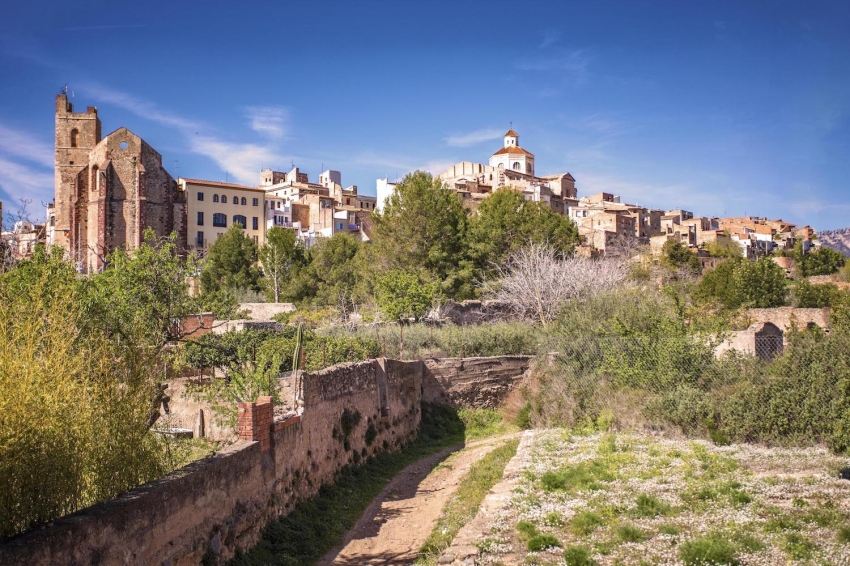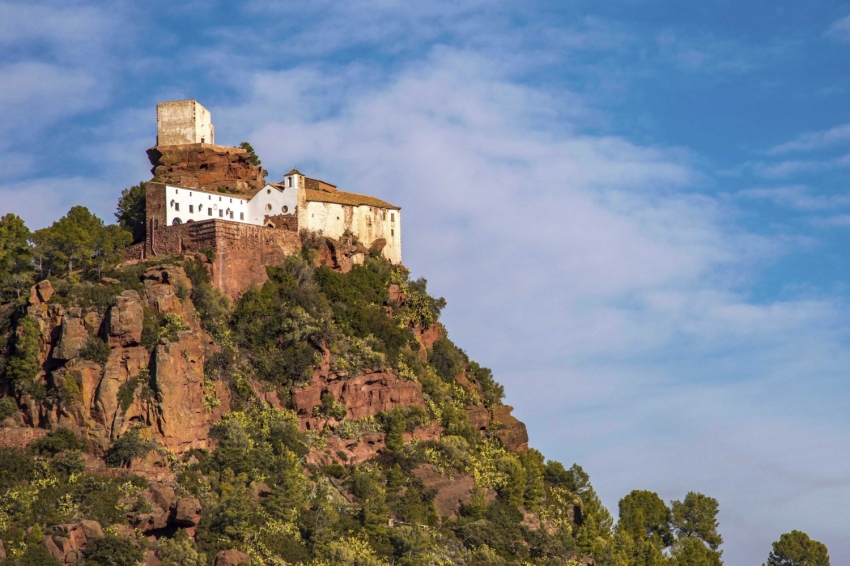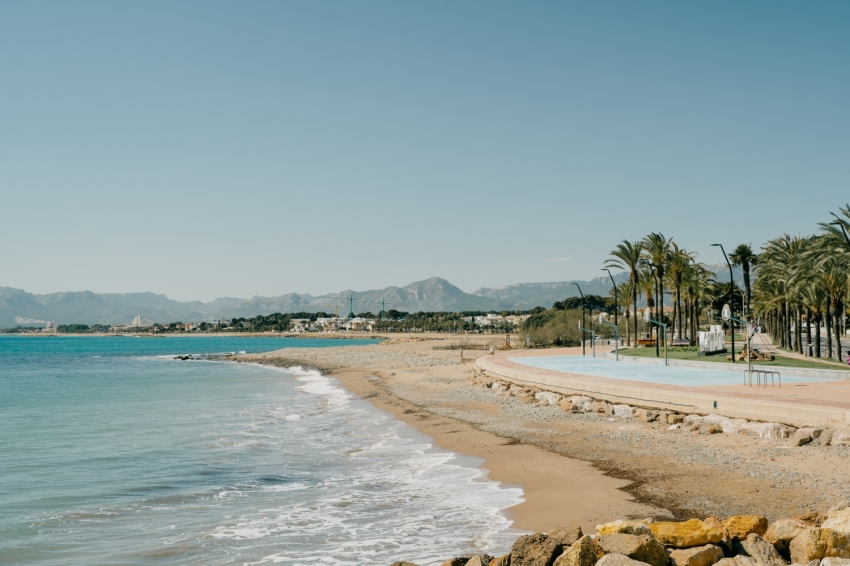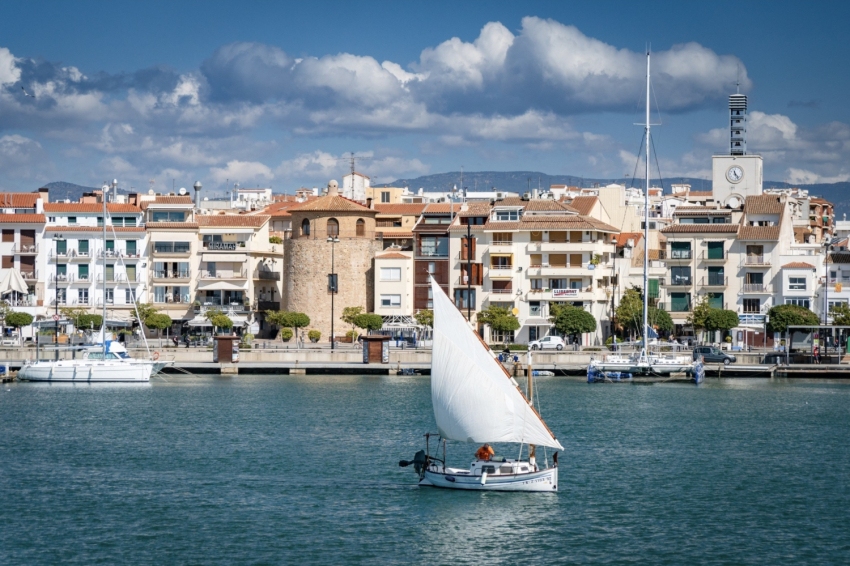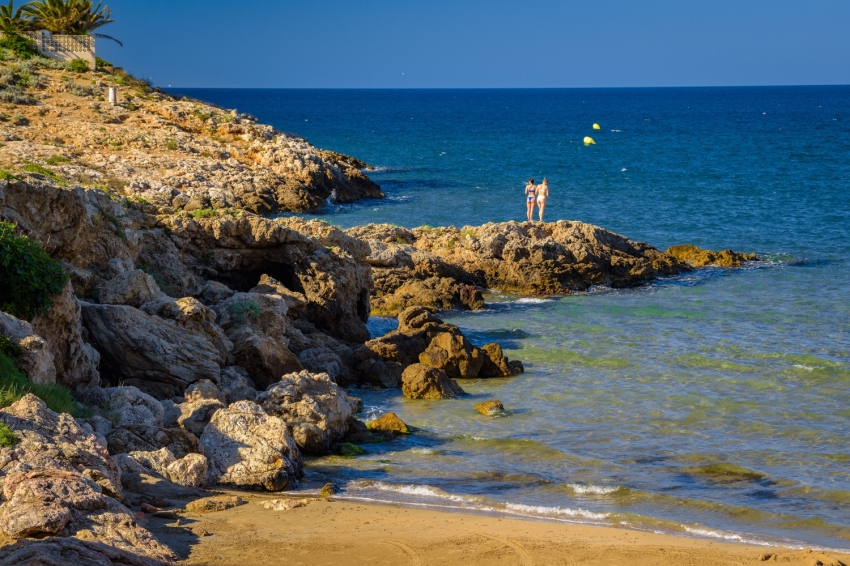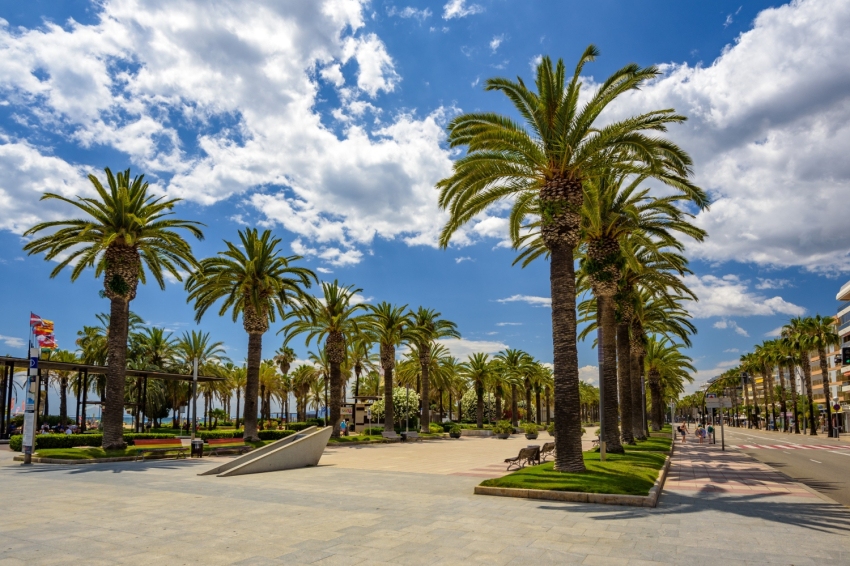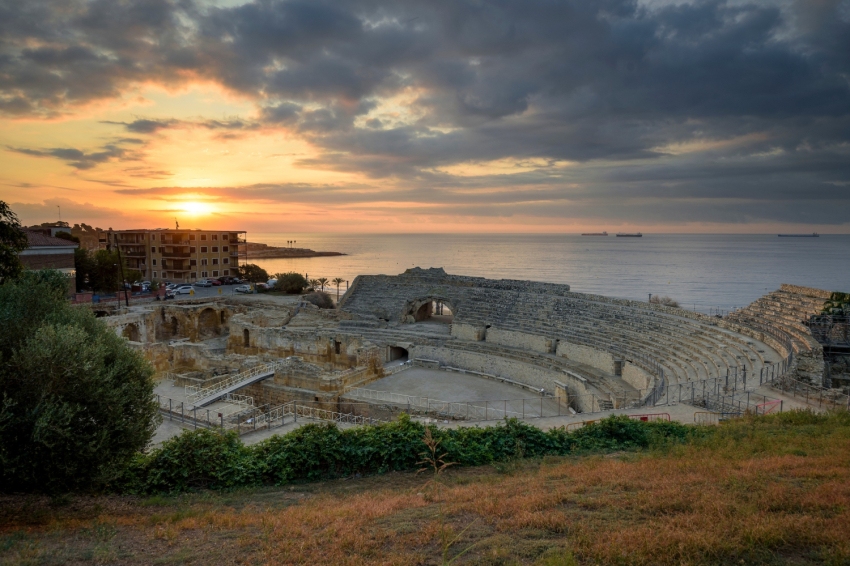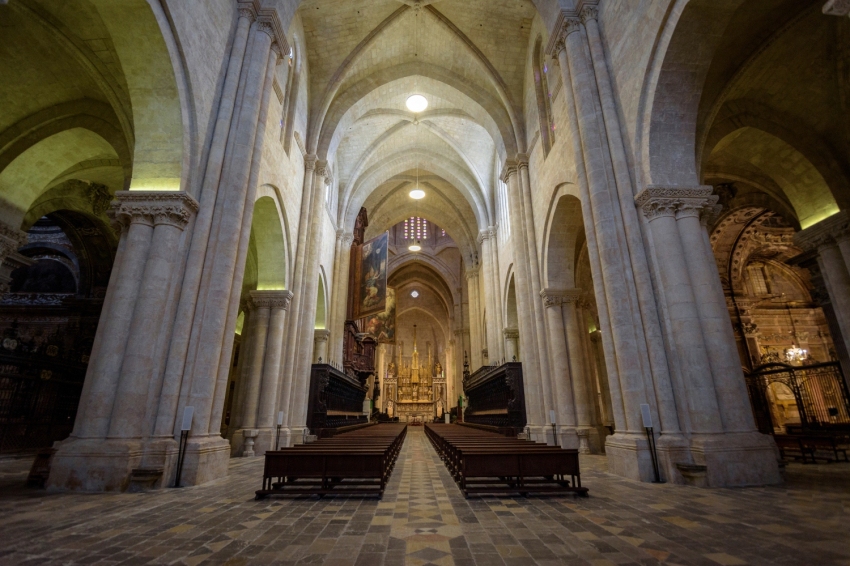From south to north along the Costa Daurada by electric car

This route is designed to be done by electric vehicle, although it can be done with any other car. Along the route we will suggest municipalities that have charging points and places of interest to visit while we charge batteries. Electric cars are a good way to decarbonise road transport These vehicles do not emit greenhouse gases and do not need fossil fuels to run, which which makes them a viable option to help reduce our CO₂ footprint.The constant improvement in the technology of these cars makes them increasingly efficient and ecological. Consult also the recommendations when traveling by electric car.![]()
![]()
6
Number of sections
![]()
80,5
Total kilometers
The Costa Daurada is one of the best-known tourist brands in Catalonia. If you are looking for a route to enjoy the sun, the sea, the beach and the summer heat, this is undoubtedly your destination.
The Costa Daurada, located in the southern part of Catalonia, has earned this name for the golden color of the sand on its beaches. And that is their great claim, but not the only one.
In addition to its charming beaches and coves, the 3,000 square kilometers that make up the stretch of Mediterranean coast between L'Hospitalet de l'Infant ( Baix Camp ) and Cunit ( Baix Penedès ) offer an almost infinite variety of tourist resources.
Among its towns and cities you can find all kinds of historical, gastronomic, landscape, leisure and cultural attractions, as well as theme parks, routes or fairs and festivals.
The Costa Daurada is made up of the Tarragona regions of Alt Camp, Baix Camp, Conca de Barberà, Priorat, Tarragonès and Baix Penedès. On this route to do by electric car mainly in the summer period, you will stop in the towns of L'Ametlla de Mar , Miami Playa, Mont-roig del Camp, Cambrils, Salou and Tarragona.
But if you prefer to do it outside the summer period and discover the places that we will present to you below, the quality of the visit will not diminish. It is true that you will not be able to swim in the sea while loading your vehicle, but as we have said, the attractions of the Costa Daurada do not end with the gold of its beaches.
Shall we prove it to you?
L'AmeTLLA de Mar, capital of bluefin tuna
The regions of Baix Ebre and Montsià are often added to the total length of the Costa Daurada. And due to its beauty and options, we have thought it appropriate to start the route in the town of L'Ametlla de Mar. This municipality in the Baix Ebre region is located in the middle of the Gulf of Sant Jordi and has a population of just over 7,000 inhabitants.
The Ametlla de Mar coast consists of 20 kilometers of coastline with 30 virgin beaches and coves with large protected areas due to their high ecological interest. You can find dozens of beaches with very different characteristics.
For example, the blue flag beaches stand out, a distinction awarded annually by the European Foundation for Environmental Education to beaches and ports that meet a series of environmental conditions and facilities, such as Cala Calafató, Cala Forn, Playa de l'Alguer or Sant Jordi Beach.
If what you are looking for are virgin beaches where nature, rocks and cliffs blind you with their beauty (green beaches), you can find Cala del Islote, Cala de Pixavaques, Cala Llenya, Cala Puerto Olivet, Cala Santes Creus, Cala Torrent del Pi or Estany podrit Beach.
Once well soaked, we recommend that you set out to discover the most special corners of the fishing village of Ametlla de Mar. This is a traditional Mediterranean fishing village, so what better way to start your visit than at the port?
Fishing is still one of the town's economic engines, so the port area of L'Ametlla de Mar has a wide range of boats and also the first fleet of tuna boats in the Principality.
Mediterranean bluefin tuna is a highly appreciated fish in the town. Fleets of fishing boats set sail from its port annually in search of their catch and the Gastronomic Days of L'Ametlla de Mar are held annually in the town. During the bluefin tuna gastronomic week, a program is presented that is aimed at professionals and the public. in general to live and taste the unique universe of bluefin tuna.
If you want to know more, the Ametlla de Mar Tuna Tour will allow you to discover the history, fishing, food, research, biology and gastronomic value of this fish, in addition to setting sail to the sea and swimming among hundreds of bluefin tunas. An unforgettable experience.
For those who like to walk through idyllic places near the sea, it is worth noting that the GR92 coastal path runs along the town's coastline and is an excellent way to discover each and every one of the town's coves and beaches.
![]()
Next stop
20,5 KM (Miami Platja)
![]()
Need to recharge?
Miami Playa, Mont-Rojo beach
In L'Ametlla, you have already seen it, you could stay all summer. There is no shortage of options. But with its beauty and the aftertaste of bluefin tuna on the palate, take the AP7 towards Miami Platja. In just 17 minutes, you will be at your next destination.
Miami Platja is a coastal urbanization located about 15 kilometers from the old town of Mont-roig del Camp. This is one of the most unique places on the Costa Daurada.
Miami Playa or Mont-roig Beach, a place name recommended by the IEC, is located between Miramar and the Llastres River, offering a spectacular perspective of the Gulf of Sant Jordi.
The coast of this site hides spaces of great natural beauty. In its more than 12 kilometers you can find beaches such as Riudecanyes or Pixerota and nine winding coves such as Cala Bot, Cala California, Cala de las Sirenas, Cala Misterio or Cala del Àngels.
But we will stop at the Estany Helado beach. This has a high natural, landscape and historical interest. Also popularly called Estany Salat beach, it is part of the Natura 2000 Network, since it is regularly visited by migratory birds and you can also find the fartet, a native freshwater fish in danger of extinction.
Animal species such as trails, chivitons, seagulls, ardeids, moorhens or vegetation such as reeds, reeds, salicornia or tamarinds turn Lake Helado into a small lagoon full of diversity, with an important history behind it, since the area was formerly an important enclave when it comes to smuggling.
The most important beach in the urbanization is Playa de Cristal, located in the middle of an urban center consisting mainly of holiday apartments and villas. You can also find a great gastronomic, hospitality and services offer. It should be noted that during the summer season Miami Platja can accommodate a population of between 80,000 and 90,000 people.
In addition to strolling along its promenade, which bustles with activity in the summer months, you can also visit the church of Santa Maria Magdalena, a curious construction made of brick that dates back to 1964.
![]()
Next stop
15,2 KM (Mont-Roig del Camp)
![]()
Need to recharge?
Miami beach
L'Hospitalet de l'Infant (1.8 km)
And meanwhile: especially if you stop in Hospitalet de l'Infant in the summer, you cannot miss a visit to the Llop Marí Cave. It is a cavity excavated by the sea in the bowels of the mountain where you can discover the legend of the Sea Wolf, a fantastic animal that attacked pirates who came to plunder the city. It is a natural paradise environment that will surely surprise you.
Mont-Roig del Camp, the inspiration of Joan Miró
And from Miami Platja, as it could not be otherwise, we recommend that you go to Mont-roig del Camp. To do this, you have different options, but the best thing is to take the road that runs along the coast, the N-340 and later the T-323, so you can enjoy the views and cliffs. In about twenty minutes you will be in the municipality of the Baix Camp region.
Mont-roig del Camp has a population of 13,000 inhabitants and an area of 63.3 km². As we have already told you before, the villa is separated into two nuclei. The coastal one, which is Miami Platja, and the old town, which is located inland. Although you will not find the sea or beaches here, you can also enjoy the different attractions of the municipality.
The first of them is undoubtedly the spectacular complex formed by the Hermitage of Nuestra Señora de la Roca and San Ramón de Peñafort. So important for the town that they are located on a reddish sandstone rock, which gives its name to the town of Mont-roig del Camp.
The reddish color of the rock is one of the most characteristic features of the area, but the two hermitages, brilliantly integrated into the mountain at 284 meters above sea level, can be visited and offer room service and a restaurant.
And if we talk about Mont-roig del Camp, we cannot forget Joan Miró, one of the most relevant painters in the country and one of the greatest representatives of surrealism. Miron's work and universe were created in this town, specifically in Mas Miró, a farm located in the southeastern sector of the town.
Joan Miró was inspired by different locations in Mont-roig del Camp to paint some of his best-known works, such as “La Masia”, “Playa”, “Mont-Roig, Sant Ramon”, “Mont-Roig, el pueblo” or “Town and Church of Mont-Roig”.
Currently, you can find a route called "The emotional landscape of Joan Miró", which guides you through the most emblematic locations of his paintings. Throughout the route, the spaces, which are identified with a panel, are complemented with quotes from the artist.
In addition, the Miró Center is also located in Mont-roig del Camp, an interpretation center that further delves into the painter's relationship with the town of Baix Camp. You will be able to see more than twenty paintings by the artist, an original tapestry, videos about his life and the testimony of several people who knew him.
![]()
Next stop
17,4 KM (Cambrils)
Cambrils
And since on this route the sun, the sea and the gold of the beach take center stage, leave the interior along the A-7 highway and head to the town of Cambrils. After a 20-minute drive, you will arrive at a new coastal town, the fourth stop on your tour.
Cambrils is a city in the El Baix Camp region that has more than 35,500 inhabitants and an area of 35.2 km². As in the previous destinations, the beaches also have a special role in Cambrils.
There you can find the Cabo de San Pedro beach, the Vilafortuny beach, the La ardilla beach, the Cavet beach, the Regueral-Prat d'en Forés beach, the Riera beach, the Horta de Santa María beach, La Llosa beach and Arcadia beach.
But Cambrils has much more than beaches. It is a city rich in gastronomy, sports and culture. Historically, Cambrils had two parts. The town and the port. Currently, due to urban growth, the two population centers have merged, but we recommend that you visit both.
The first, the old neighborhood of Cambrils, will help you discover the origins and history of the city. Narrow, cobblestone streets, with charming corners that are more unknown than the beaches, but no less attractive. The labyrinth of streets with flower-filled balconies and historic buildings converge in the Plaza de la Vila, where you can stroll peacefully and have a drink in one of its cafes.
The second area, the Port neighborhood, is recognized with the Barri Mariner badge from the Catalan Tourism Agency. The Port of Cambrils has two different parts, the marina and the fishing port. And we will tell you more details about the second, since it has a great history and tradition behind it.
Cambrils has always been linked to fishing. Every afternoon you can see the arrival of the fishing boats accompanied by hundreds of seagulls looking for their small meal. Currently, thirteen trawl boats go to sea from the Port of Cambrils that fish for bream, hake, galleys, squid and octopus, 4 purse seine boats that catch sardines and anchovies, and 7 trammel boats, destined for fishing soles, docks, cuttlefish. and hake. If you want to learn more about this ancient trade rooted in the city, you can do so by visiting the brotherhood where fresh fish is sold or boarding fishing boats in the multiple tourist experiences offered from the town.
And all these fishing boats have one thing in common: the Red Lighthouse of Cambrils is in charge of guiding them. This is located at the tip of the breakwater of the town's port and thanks to its intense red color it is one of the best-known and most photographed places in Cambrils.
![]()
Next stop
11 KM (Salou)
Salou and its beaches
And from Cambrils, to Salou. On the N-340 highway with your electric vehicle, you will arrive in just over 15 minutes. Located in the Tarragonès region, the municipality of Salou has 29,028 inhabitants (2022) and an area of 15.1 km².
Salou is one of the leading tourist destinations in Catalonia, especially due to its proximity to the well-known Port Aventura amusement park. But leaving this fact aside, the municipality has a long history that we encourage you to discover.
As for the beaches, you can find 9 along its also 9 kilometers of seafront. In addition, you will find quieter and more remote coves. The main bathing areas are the Ponent and Levante beaches, which are the most urban . You can also find Capellans beach, Lenguadets beach, Larga beach, Peña Tallada beach, Font beach, Vinya beach and Los Cangrejos beach.
And to get there, you will have to go through the promenade, one of the most appreciated and well-known places in Salou. The name of the walk is Jaume I and it is located parallel to the Levante beach.
This is characterized by its palm trees and flowers throughout the route. It is an ideal place for walking by the sea, with a multitude of shops, bars and restaurants. We could affirm that it is the nerve center of Salou. In addition, the prominent monument made to Jaime I in 1965 and also the Font Lluminosa stand out.
The Font Lluminosa is located at the end of Paseo Jaume I, specifically in Plaza Francesc Germà. The large fountain offers visitors spectacular games of water, light and colors, which will delight young and old alike. Above all, if you visit at night, the visual experience increases considerably. Its water and light games can reach up to 210 combinations, so, to contemplate the entire program, you can sit on a bench and wait, since it should last more than 5 hours. The fountain was built in 1973 by Carles Buïgas, an engineer who also created the monumental Montjuïc fountain in Barcelona.
The last recommendation we will make for you in Salou is the Torre Vella. Currently, it is an art center dedicated to exhibitions, especially paintings, and houses the museum of contemporary enamel.
But the tower was built by Archbishop Pere Cardona of Tarragona in 1530 with the main objective of catching a glimpse of pirate attacks. Salou was a town heavily attacked by corsairs, as it was one of the epicenters of maritime trade in the 16th, 17th and 18th centuries. For this reason, defense towers were built, as in the case of the Torre Vella.
![]()
Next stop
16,4 KM (Tarragona)
![]()
Need to recharge?
Salou
Reus (9.2 km away)
![]() Carrer de Cambrils, 0, 43204 Reus, Tarragona
Carrer de Cambrils, 0, 43204 Reus, Tarragona
And in the meantime: if you stop in Reus to charge your electric vehicle, we recommend that you follow the past of Antoni Gaudí. The architect was born in Reus and lived there for the first years of his life. For this reason, it has left an indelible mark that today can be followed in different ways. You will find the "Gaudí&Reus" route, guided tours that will take you to know more about his childhood and, above all, the Gaudí Center. A spectacular and modern interpretation center on the life and work of the most universal architect of Reus.
Tarragona, the Roman Tarragona
And yes, Tarragona. After the abundance of sun, sea, beach and golden sand, you have reached the final point of the route, the monumental and historic capital of the Tarragonès region and the province of Tarragona. To get there from Salou, take the AP-7 again and in just under 20 minutes you will be in the center of the city.
Tarragona has a population of close to 135,000 inhabitants and a territorial area of 57.9 km². As it could not be otherwise on this route, Tarragona also has 15 kilometers of coast where you can find several beaches and attractive coves with crystal clear waters. But as a beach you have already had enough in the rest of your route, we will focus on the history and heritage of the capital of Tarragonès, since it is rich and abundant.
And you will start, of course, with Roman Tarraco, where you can learn about the city's glorious past. Founded as a military camp by the Romans in the 3rd century BC. C., Tarragona preserves the traces of an ancient civilization.
The walls of Tarraco, the Tarraco amphitheater, the Les Ferreres aqueduct (known as the Devil's Bridge ), the Tarraco forum, the Tarraco theater or the Tarraco circus are just some of the examples of everything you can visit in Tarragona related to the presence of the Romans.
Declared World Heritage by UNESCO in 2000, the Roman remains are an exceptional testimony of the Roman footprint on the Iberian Peninsula and their beauty will not leave you indifferent. You will relive the history of the city in first person and, in addition, you will be able to find dozens of activities related to Roman Tarraco such as museums, tourist routes or workshops.
Another of the most relevant heritage buildings in Tarragona is its imposing cathedral. The Cathedral of Tarragona, dedicated to Santa Tecla, began to be built during the 12th century and is in the Gothic style. This is the largest cathedral in Catalonia and has been declared a National Monument and also a Cultural Asset of National Interest. Its façade, with the doorway and rose window, is one of the most emblematic images of the city. Inside you can find the Diocesan Museum and the altarpiece of Santa Tecla. Guided tours are organized in the cathedral that will help you discover all its corners full of stories and lavish details.
And... we return to the sea to finish a route that begins and ends with the sweet aroma of the sea. El Serrallo is the fishing neighborhood of Tarragona. The capital of Tarragona has a long tradition of fishing activity and here you can try it with all your senses.
The neighborhood has a great gastronomic, cultural, associative and economic activity, focused mainly on fishing and the sea since time immemorial. Mainly, El Serrallo has become a gastronomic reference point due to its ideal location, located next to the sea. So to finish this route well, walk through the neighborhood, sit in one of its restaurants and enjoy fresh fish or moixina suquet with potatoes with aioli, one of the typical traditional dishes of the neighborhood.
In collaboration with
Etecnic is the leader in 360° installations of electric, connected and renewable mobility. It has carried out more than 1,100 projects, manages more than 7,000 electric vehicle charging points, has more than 700,000 registered users on its EVcharge APP, for which it has delivered more than 3 million hours of recharge and reduced more than 21,000 tons of CO₂.
You may also be interested in: Reduce your ecological footprint | Discover Catalonia by electric car
What to do
Muntanyes de la Costa Daurada
The municipalities of the Costa Daurada Mountains make up a territory of…
Pessebre Vivent Pobla de Montornès
La Pobla de Montornès (a 15 Km)A living manger is the representation of the birth of Jesus of…
Granja Escola Corral de Neri
El Catllar (a 8.4 Km)At the Farm you can take guided tours, celebrate traditional festivals, celebrate…
Where to eat
Restaurant Denver Cambrils
Cambrils (a 1.3 Km)The history of the Denver begins many years ago, as many as…
L'Orangerie de Clos Barenys
Vila-seca (a 2.8 Km)Under our fires, we prepare haute Mediterranean cuisine by selecting the finest…
Arena Tapas Restaurant
SalouEnjoy an innovative cuisine, with high-quality local products of proximity, with an…
L’Estany - Casa de Fusta
Amposta (a 27.3 Km)Regional cuisine restaurant, with a wide sample of the ancestral cuisine of…
Where to sleep
Càmping La Llosa
Cambrils (a 1.3 Km)We address a family audience, that's why we have been awarded the…
Apartaments TGNA Reial 1
TarragonaTGNA Reial 1 is an apartment building ideally located in Tarragona, just…
Càmping Alannia Costa Dorada
Vandellòs i l'Hospitalet de l'Infant (a 7.6 Km)Alannia Costa Dorada is located in an environment with direct access to…

